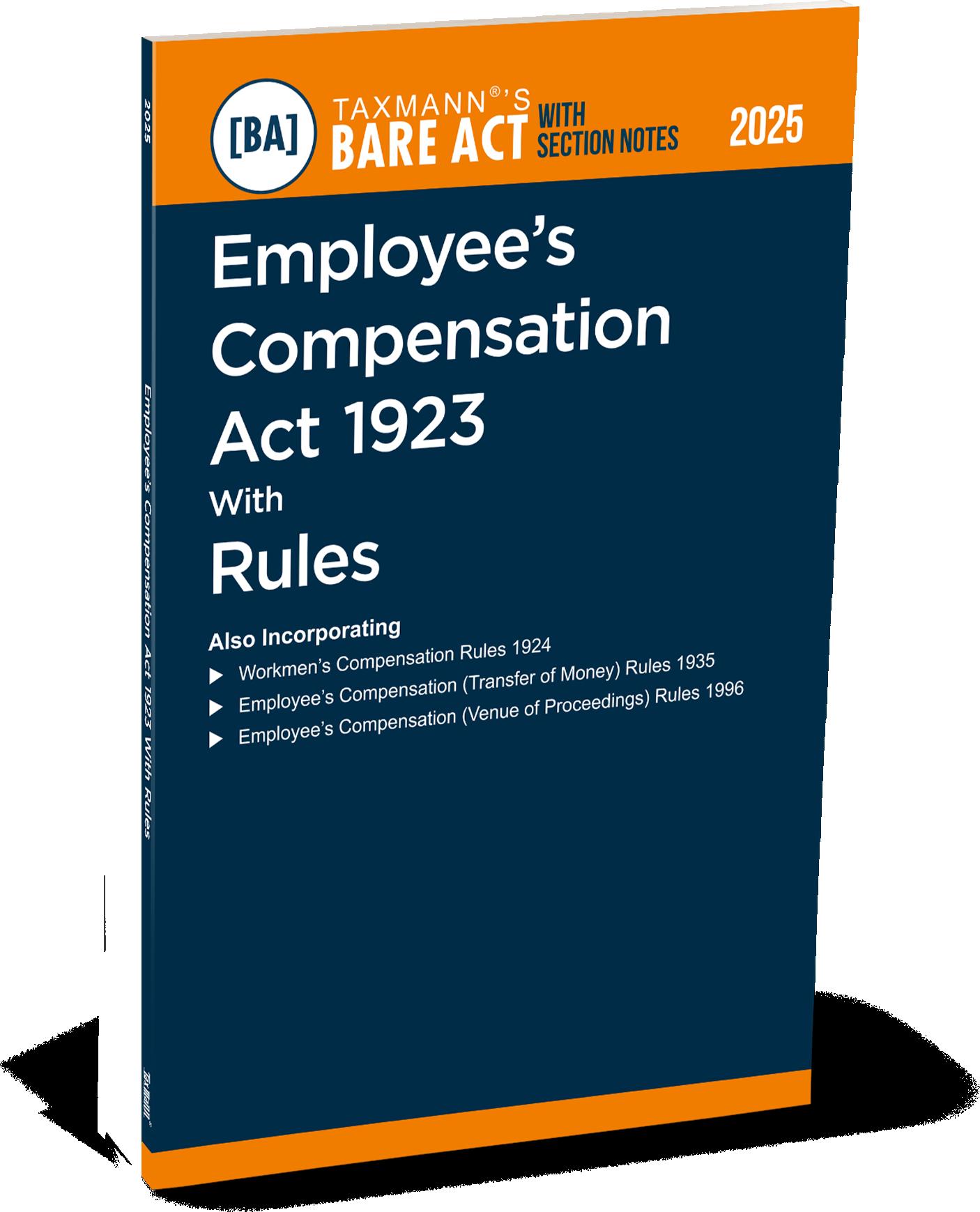EMPLOYEE’S COMPENSATION ACT, 1923
CHAPTER III COMMISSIONERS
CHAPTER IV RULES
32. Power of the State Government to make rules 49
33. [Omitted by the Government of India (Adaptation of Indian Laws) Order, 1937] 51
34. Publication of rules 51
35. Rules to give effect to arrangements with other countries for the transfer of money paid as compensation 51
36. Rules made by Central Government to be laid before Parliament 52
WORKMEN’S COMPENSATION RULES, 1924 PRELIMINARY
PART I
REVIEW OF HALF-MONTHLY PAYMENTS AND COMMUTATION THEREOF
3. When application may be made without medical certificate 71
4. Procedure on application for review
5. Procedure on application for commutation
PART II DEPOSIT OF COMPENSATION
6. Deposit under section 8(1) 72
7. Publication of list of deposits 73
8. Application by dependants for deposit of compensation
9. Deposit under section 8(2)
10. Investment of money
PART III REPORTS OF ACCIDENTS
11. Report of fatal accidents 73
12. Right of employer to present memorandum when information received 74
PART IV
MEDICAL EXAMINATION
13. Workman not to be required to submit to medical examination save in accordance with rules 74
14. Examination when workman and medical practitioner both on premises 74
15. Examination in other cases 74
16. Restriction on number of examinations 74
17. Examination after suspension of right to compensation 75
18. Examination of women 75
PART V PROCEDURE
19. Introductory
20. Application
21. Production of documents
22. Application presented to wrong Commissioner
23. Examination of applicant
24. Summary dismissal of application
25. Preliminary inquiry into application
26. Notice to opposite party
27. Appearance and examination of opposite party
28. Framing of issues
29. Power to postpone trial of issues of facts where issues of law arise
30. Diary 77
31. Reasons for postponement to be recorded
32. Judgment 77
33. Summoning of witnesses
34. Exemption from payment of costs
CONTENTS
35. Right of entry for local inspection 78
36. Procedure in connection with local inspection 78
37. Power of summary examination 78
38. Agreement to abide by Commissioner’s decision 79
39. Procedure where indemnity claimed under section 12(2) 79
40. Procedure in connected cases 80
41. Certain provisions of Code of Civil Procedure, 1908 to apply 80
42. Provision regarding signature of forms 81
43. Apportionment of compensation among dependants 81
PART VI
TRANSFER
44. Transfer for report 81
45. Transmission of money 81
PART VII
APPOINTMENT OF REPRESENTATIVES
46. When representatives must be appointed 81
47. When new representative to be appointed 81
PART VIII
RECORD OF MEMORANDA OF AGREEMENT
48. Form of memorandum 82
49. Procedure where Commissioner does not consider that he should refuse to record memorandum 82
50. Procedure where Commissioner considers he should refuse to record memorandum 82
51. Procedure on refusal to record memorandum 83
52. Registration of memorandum accepted for record 83
FORM A: Deposit of Compensation for Fatal Accident 83
FORM AA: Deposit of Compensation for non-fatal accident to a woman or person under legal disability 84
FORM B: Receipt for Compensation 84
FORM C: Statement of Disbursements 85
FORM D: Deposit of Compensation for non-fatal Accidents, other than to a Woman or Person under Legal Disability 85
FORM
Employee’s Compensation Act, 1923† [8
OF 1923]*
An Act to provide for the payment by certain classes of employers to their 1[employees] of compensation for injury by accident.
WHEREAS it is expedient to provide for the payment by certain classes of employers to their 1[employees] of compensation for injury by accident; it is hereby enacted as follows :—
CHAPTER I PRELIMINARY
Short title, extent and commencement.
1. (1) This Act may be called the 2[Employee’s] Compensation Act, 1923.
3[(2) It extends to the whole of India 4[***].]
(3) It shall come into force on the first day of July, 1924.
COMMENTS
SECTION NOTES
1.1 Short title [Section 1(1)]
The Act is officially named as the “Employee’s Compensation Act, 1923”.
1.2 Extent of application [Section 1(2)]
The Act is extended to apply throughout the entire territory of India.
*Dated 5-3-1923.
†Repealed by the Code on Social Security, 2020, with effect from a date yet to be noti ed.
1. Substituted for “workmen” by the Workmen’s Compensation (Amendment) Act, 2009, w.e.f. 18-1-2010.
2. Substituted for “Workmen’s”, ibid.
3. Substituted by the Adaptation of Laws Orders, 1950.
4. Words “except the State of Jammu and Kashmir” omitted by the Central Labour Laws Extension to (Jammu and Kashmir) Act, 1970, w.e.f. 1-9-1971. Earlier the quoted words were substituted for “except Part B States” by the Part B States (Laws) Act, 1951.
1.3 Commencement date [Section 1(3)]
The Act came into operation on July 1, 1924.
Definitions.
2. (1) In this Act, unless there is anything repugnant in the subject or context,—
(a) 5[***];
(
b) “Commissioner” means a Commissioner for 5a[Employee’s] Compensation appointed under section 20;
(c) “compensation” means compensation as provided for by this Act;
6[(d) “dependant” means any of the following relatives of a deceased 7[employee], namely :—
(i) a widow, a minor 8[legitimate or adopted] son, and unmarried 8[legitimate or adopted] daughter, or a widowed mother; and
(ii) if wholly dependent on the earnings of the 7[employee] at the time of his death, a son or a daughter who has attained the age of 18 years and who is infirm;
(iii) if wholly or in part dependent on the earnings of the 7[employee] at the time of his death,
(a) a widower,
(
(
b) a parent other than a widowed mother,
c) a minor illegitimate son, an unmarried illegitimate daughter or a daughter 9[legitimate or illegitimate or adopted] if married and a minor or if widowed and a minor,
(d) a minor brother or an unmarried sister or a widowed sister if a minor,
(e) a widowed daughter-in-law,
(f) a minor child of a pre-deceased son,
(g) a minor child of a pre-deceased daughter where no parent of the child is alive, or
(h) a paternal grandparent if no parent of the 9[employee] is alive.]
10[Explanation.—For the purposes of sub-clause (ii) and items (f) and (g) of sub-clause (iii), references to a son, daughter or child include an adopted son, daughter or child respectively;]
5. Omitted by the Workmen’s Compensation (Amendment) Act, 1959, w.e.f. 1-6-1959.
5a. Substituted for “Workmen’s by the Workmen’s Compensation (Amendment) Act, 2009, w.e.f. 18-1-2010.
6. Substituted by the Workmen’s Compensation (Amendment) Act, 1959, w.e.f. 1-6-1959.
7. Substituted for “workman” by the Workmen’s Compensation (Amendment) Act, 2009, w.e.f. 18-1-2010.
8. Substituted for “legitimate” by the Workmen’s Compensation (Amendment) Act, 1995, w.e.f. 15-9-1995.
9. Substituted for “legitimate or illegitimate”, ibid
10. Inserted, ibid. S. 2 EMPLOYEE’S COMPENSATION ACT, 1923 2
3
11[(dd) “employee” means a person, who is—
(i) a railway servant as defined in clause (34) of section 2 of the Railways Act, 1989 (24 of 1989), not permanently employed in any administrative district or sub-divisional office of a railway and not employed in any such capacity as is specified in Schedule II; or (ii) (a) a master, seaman or other member of the crew of a ship, (b) a captain or other member of the crew of an aircraft, (c) a person recruited as driver, helper, mechanic, cleaner or in any other capacity in connection with a motor vehicle, (d) a person recruited for work abroad by a company, and who is employed outside India in any such capacity as is specified in Schedule II and the ship, aircraft or motor vehicle, or company, as the case may be, is registered in India; or (iii) employed in any such capacity as is specified in Schedule II, whether the contract of employment was made before or after the passing of this Act and whether such contract is expressed or implied, oral or in writing; but does not include any person working in the capacity of a member of the Armed Forces of the Union; and any reference to any employee who has been injured shall, where the employee is dead, include a reference to his dependants or any of them;]
12[(e) “employer” includes anybody of persons whether incorporated or not and any managing agent of an employer and the legal representative of a deceased employer, and, when the services of an 13[employee] are temporarily lent or let on hire to another person by the person with whom the 13[employee] has entered into a contract of service or apprenticeship, means such other person while the 13[employee] is working for him;}
(f) “managing agent” means any person appointed or acting as the representative of another person for the purpose of carrying on such other person’s trade or business, but does not include an individual manager subordinate to an employer;
14[(ff) “minor” means a person who has not attained the age of 18 years;]
(g) “partial disablement” means, where the disablement is of a temporary nature, such disablement as reduces the earning capacity of a 13[employee] in any employment in which he was engaged at the time of
11. Inserted by the Workmen’s Compensation (Amendment) Act, 2009, w.e.f. 18-1-2010.
12. In its application to the ‘apprentices’ following clause (e) substituted by the Apprentices Act, 1961, w.e.f. 11-3-1962. Prior to its substitution clause (e) read as under:
‘(e) “employer” means an employer as defined in the Apprentices Act, 1961, who has engaged one or more apprentices,’
13. Substituted for “workman” by the Workmen’s Compensation (Amendment) Act, 2009 w.e.f. 18-1-2010.
14. Inserted by the Workmen’s Compensation (Amendment) Act, 1959, w.e.f. 1-6-1959.
S. 2
EMPLOYEE’S COMPENSATION ACT, 1923 4
the accident resulting in the disablement, and, where the disablement is of a permanent nature, such disablement as reduces his earning capacity in every employment which he was capable of undertaking at that time:
Provided that every injury specified 15[in Part II of Schedule I] shall be deemed to result in permanent partial disablement;
(h) “prescribed” means prescribed by rules made under this Act;
(i) “qualified medical practitioner” means any person registered 16[***] under any 17[Central Act, Provincial Act or an Act of the Legislature of a 18[State]] providing for the maintenance of a register of medical practitioners, or, in any area where no such last-mentioned Act is in force, any person declared by the State Government, by notification in the Official Gazette, to be a qualified medical practitioner for the purposes of this Act;
(j) 19[***]
20[(k) “seaman” means any person forming part of the crew of any 21[***] ship, but does not include the master of 22[the] ship;}
(l) “total disablement” means such disablement, whether of a temporary or permanent nature, as incapacitates a 23[employee] for all work which he was capable of performing at the time of the accident resulting in such disablement:
24[Provided that permanent total disablement shall be deemed to result from every injury specified in Part I of Schedule I or from any combination of injuries specified in Part II thereof where the aggregate percentage of the loss of earning capacity, as specified in the said Part II against those injuries, amounts to one hundred per cent or more;]
25[(m) “wages” includes any privilege or benefit which is capable of being estimated in money, other than a travelling allowance or the value of any travelling concession or a contribution paid by the employer of a
15. Substituted for “in Schedule I” by the Workmen’s Compensation (Amendment) Act, 1962, w.e.f. 1-2-1963.
16. Words “under the Medical Act, 1858, or any Act amending the same, or” omitted by the Workmen’s Compensation (Amendment) Act, 1959, w.e.f. 1-6-1959.
17. Substituted for “Act of the Central Legislature or of any Legislature in a Province of India” by the Adaptation of Laws Order 1950.
18. Substituted for “Part A State or Part B State” by the Adaptation of Laws (No. 3) Order, 1956. Earlier these words were substituted for “Part A State” by the Part B States (Laws) Act, 1951, w.e.f. 1-4-1951
19. Clause (j) omitted by Workmen’s Compensation Act, 1933.
20. Clause (k) omitted in its application to the ‘apprentices’ by the Apprentices Act, 1961, w.e.f. 11-3-1962.
21. Word “registered” omitted by Workmen’s Compensation Act, 1933.
22. Substituted for “any such”, ibid
23. Substituted for “workman” by the Workmen’s Compensation (Amendment) Act, 2009, w.e.f. 18-1-2010.
24. Substituted by the Workmen’s Compensation (Amendment) Act, 1962, w.e.f. 1-2-1963.
25. In its application to the ‘apprentices’, the following clause substituted by the Apprentices Act, 1961, w.e.f. 11-3-1962 :
‘(m) “wages” means the stipend payable to an apprentice under section 13(1) of the Apprentices Act, 1961;’
5 EMPLOYEE’S COMPENSATION ACT, 1923 S. 2
25a[employee] towards any pension or provident fund or a sum paid to a 25a[employee] to cover any special expenses entailed on him by the nature of his employment;]
(n) 26[***].
(2) The exercise and performance of the powers and duties of a local authority or of any department 27[acting on behalf of the Government] shall, for the purposes of this Act, unless a contrary intention appears, be deemed to be the trade or business of such authority or department.
28[(3) The Central Government or the State Government, by notification in the Official Gazette, after giving not less than three months’ notice of its intention so to do, may, by a like notification, add to Schedule II any class of persons employed in any occupation which it is satisfied is a hazardous occupation, and the provisions of this Act shall thereupon apply, in case of a notification by the Central Government, within the territories to which the Act extends, or, in the case of a notification by the State Government, within the State, to such classes of persons:
Provided that in making addition, the Central Government or the State Government, as the case may be, may direct that the provisions of this Act shall apply to such classes of persons in respect of specified injuries only.]
25a. Substituted for “workman” by the Workmen’s Compensation (Amendment) Act, 2009, w.e.f. 18-1-2010.
26. Omitted, ibid. Prior to its omission, clause (n), as amended by the Workmen’s Compensation (Amendment) Act, 1933, the Workmen’s Compensation (Amendment) Act, 1937, the Adaptation of Laws Order, 1950, Apprentices Act, 1961, w.e.f. 11-3-1962, Workmen’s Compensation (Amendment) Act, 1962, w.e.f. 1-2-1963, Workmen’s Compensation (Amendment) Act, 1976, w.r.e.f. 1-10-1975, Workmen’s Compensation (Amendment) Act, 1984, w.e.f. 1-7-1984, Workmen’s Compensation (Amendment) Act, 1995, w.e.f. 15-9-1995, and the Workmen’s Compensation (Amendment) Act, 2000, w.e.f. 8-12-2000, read as under: ‘(n) “workman” means any person who is—
(i) a railway servant as defined in clause (34) of section 2 of the Railways Act, 1989 (24 of 1989), not permanently employed in any administrative, district or sub-division office of a railway and not employed in any such capacity as is specified in Schedule II, or (ia) (a) a master, seaman or other member of the crew of a ship,
(b) a captain or other member of the crew of an aircraft,
(c) a person recruited as driver, helper, mechanic, cleaner or in any other capacity in connection with a motor vehicle,
(d) a person recruited for work abroad by a company, and who is employed outside India in any such capacity as is specified in Schedule II and the ship, aircraft or motor vehicle, or company, as the case may be, is registered in India, or
(ii) employed in any such capacity as is specified in Schedule II, whether the contract of employment was made before or after the passing of this Act and whether such contract is expressed or implied, oral or in writing; but does not include any person working in the capacity of a member of the Armed Forces of the Union; and any reference to a workman who has been injured shall, where the workman is dead, include a reference to his dependants or any of them.’
27. Substituted for “of the Government” by the Workmen’s Compensation (Amendment) Act, 1937.
28. Substituted by the Workmen’s Compensation (Amendment) Act, 1995, w.e.f. 15-9-1995.






